God rest her soul, my mother was clearly unhappy. Flapping in the backyard breeze, a bright crimson line striped her freshly laundered bed sheet from the clothesline. The oak tree above, and squirrel in a heap underneath, linked the suspect to the crime. Too bad I hadn’t been able to sanitize the scene before Mom appeared but, if nothing else, the 35-yard shot from my next door neighbor’s upstairs window was a doozie.
by Steve Markwith, author of Air Rifles: A Buyer’s and Shooter’s Guide
Kids, Air Rifles, and Squirrels
On a dare, my teenage buddy, Larry, had challenged me to demonstrate the “raw power” of my new pump-up Sheridan air rifle. He’d set up a makeshift airgun range in his attic and initial testing was underway. That’s when a large gray squirrel decided to pause on a branch high above my backyard. Barely skipping a beat, I frantically stroked in the maximum 8 pumps of air, cocked the bolt, and seated a .20-caliber pellet.
Next, I leaned out Larry’s attic window as he peered over my shoulder, aimed a bit high, and squeezed. The cylindrical-pointed lead pellet arched into the squirrel with a loud smack and it plummeted from its lofty perch. Larry was impressed. My mother, not so much. Turned out the shot had drilled its upper body and severed an artery, creating an impressive rodent airbrush. For some time thereafter, any meager funds intended for pellets helped fund new linens.
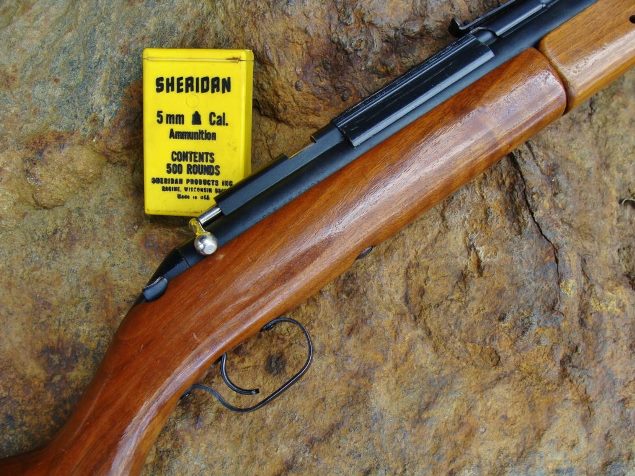
But, the good news was, the .20-caliber air rifle was indeed a major step above our previous artillery, which consisted of a BB gun and pump-up .177 pellet pistol. Neither produced humane results on gray squirrels, whereas the Sheridan’s heavier and faster pellets seemed to hit like Thor’s hammer. As young teenagers though, that was the extent of our experience. Since then, several decades have provided more insight.
The Lowdown on Gray Squirrels
Actually, city dwellers may not even realize squirrels are legitimate game animals. They’re a popular small game quarry for some people living in more rural areas. Classic squirrel hunts typically involve tree-dwelling eastern grays, which are common to many U.S. regions. Grays thrive on nuts and thus prefer hardwoods that produce mast crops like acorns and other nuts.
Suburbs often serve squirrels nicely offering plenty of food with few predators. Domestic threats (like Felix or Rover) are easily avoided by scrambling up the nearest tree. Beyond the fact that they’re true acrobats, squirrels are also resourceful and persistent. True bird feeder bandits, they’re often the inspiration for some airgun shopping.
But rural gray squirrels have little in common with their urban counterparts. Beyond humans, they’re pursued by a number of predatory threats, leaving only the wary to breed. However, they all taste the same – a lot like chicken! For this reason, gray squirrels actually were a main food staple for much of colonial America. They’ve also graced many tables since, a tradition that continues today.
Other Squirrel Species
In my area of northern New England, mast-producing hardwoods are less common than in areas further south, so our gray squirrel populations are more spotty. Red squirrels fill in this void due to their preference for softwood. They’re smaller, hyperactive, and usually considered pests, subject to bombardment by whatever’s available, including BB guns. Size-wise, they fall between eastern grays and chipmunks (the latter being small ground-dwellers) so reds are less often table fare.
Conversely, fox squirrels run larger than grays. Sometimes they intermix, but most inhabit central and southern regions. There are several other edible squirrel species more common in the west, some of which inhabit coniferous forests. I’ll reference grays from here out though, because that’s what I grew up with.
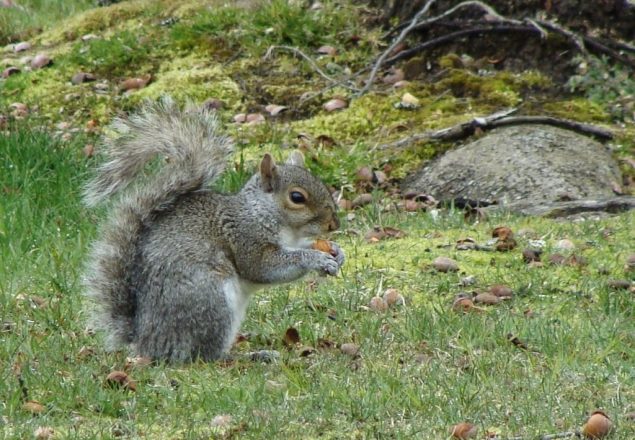
Locating Gray Squirrels
Good squirrel cover can vary depending on the area and predominant food source. A creek that meanders through lowlands could be a hotspot if lined by white oak. But, so could a well-drained hillside studded with mature red oak trees or other mast-producing hardwoods, such as hickory. Look skyward to spot squirrel nests; large leafy balls, often tucked in the crotches of trees, well above ground level. Fresh nests will guarantee gray squirrels, but in my area, holes in tree trunks are sometimes substituted. A possible reason is predation from large weasel-like fishers, which can easily climb trees to ravage any exposed nests (which can house several squirrels).
Fresh nut cuttings are another great indicator of squirrels. During early fall you’ll find chewed shell fragments on stumps and rocks wherever mast crops and squirrels coincide.

A quiet September morning is great for a scouting trip. Hit the woods shortly after sunrise and you’ll often hear them climbing, jumping between trees, dropping nut-cuttings, or digging through leaves on the ground. Squirrels are vocal, too. They’ll chatter from perches or even emit a cat-like whine. They’ll also congregate in pockets that offer ready food sources and nesting sites, usually with a water source nearby.
Squirrels can also relocate from one season to the next. In some areas, agriculture factors in to the point where they can become a major problem. They’ll build nests in wooded field edges, and then raid crops – typically right before the harvest.
Gray Squirrel Hunting Methods
Seasons vary, but grays are regulated as game animals in many states. Ours runs October through December with a daily bag limit of four. Early-season hunting is better because our squirrels are actively gathering nuts in preparation for long New England winters. Prime time is early morning and late afternoon, although squirrels may sleep in during cold mornings.
Deep in Dixie, squirrel hunting is a bigger event and it often involves a prized squirrel dog. Once treed, squirrels are notorious for their ability to remain on an opposite side where they’ll flatten against a trunk or limb. A solo hunter can wind up with little more than a stiff neck, but a good dog can solve that problem (so can another hunter). Some squirrels will leap tree-to-tree presenting difficult targets, so shotguns are often preferred.
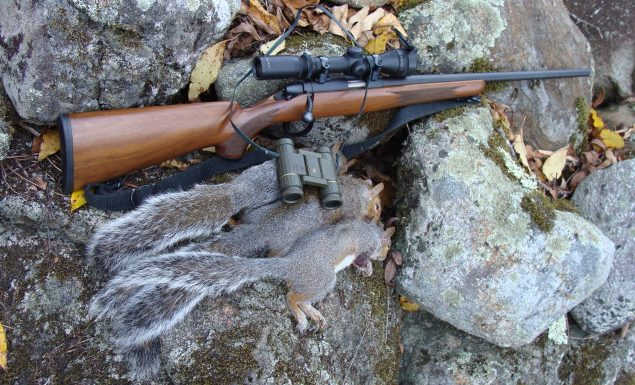
Some areas are shotgun-only for safety reasons, since what goes up will come down. That was the law where I grew up, so lacking more than a single-shot 12 gauge, I just wandered the woods – and learned to hunt.
Nowadays, during the month before our deer season, I enjoy a sunny October morning hunting as I would for whitetails, but carrying a scoped .22 rifle. I may sneak into a hotspot and sit on a stump, picking off several squirrels as they appear, or I might “still hunt” at a slow pace while listening for them. Either way, a compact set of binoculars is essential, along with a sling for the rifle.
This type of hunting is great practice for more serious pursuits. You’ll get good at shooting off improvised rests (tree trunks), and from different positions or angles. Beyond the sling, a hunting vest or game bag will free up both hands for the binos – and make carrying squirrels much easier. Some basic camo clothing is also helpful, but that’s about the extent of gear you’ll need.
Air Rifles for Squirrel Hunting
Pound-for-pound, gray squirrels are downright tough, probably because they have to be. They’re true high-wire artists, but I’ve also witnessed a few that missed jumps and survived amazing falls. I came to realize that my mighty Sheridan would indeed take grays, but only through careful shooting at conservative ranges.
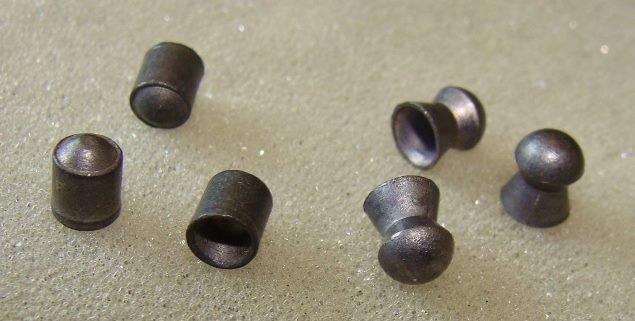
Turned out that 35-yard shot was a bit of a fluke, especially in light of the Sheridan’s open sights. Now long-gone from production, its .20-caliber projectiles weighed around 14.5 grains and clocked about 600 feet per second (fps). However, 35 yards is entirely doable if similar-weight (14.3 grain) .22-caliber pellets are boosted to 800 fps – or more.
Related post: Modern Airguns: Calibers, Power, and Types
This velocity is attainable with some barrel-cocking “springers” and many pre-charged pneumatic rifles, all of which should be scoped for precise shots to vitals. Eventually, I moved up to 16-grain pellets at 900 fps. They hit noticeably harder, but shot placement is still critical, and 50 yards is pushing the envelope. Most squirrels will be closer, but shots can still be tricky due to their ability to flatten out in tall trees.
Fortunately, these skyward airgun shots are much safer than those from .22 rimfires which can travel a mile or more! Instead, we’re talking several hundred yards. And being intrinsically quiet, airguns are much less likely to alarm local residents – or other nearby squirrels! Sneak into a hotspot and you’ll probably get multiple opportunities.
.22 Rimfire Rifles for Squirrel Hunting
You could use a snappy rimfire .17, or a .22 Magnum, but beyond concerns over their greater carrying distances, most will cause excessive meat damage. The .22 Long Rifle is a better choice.
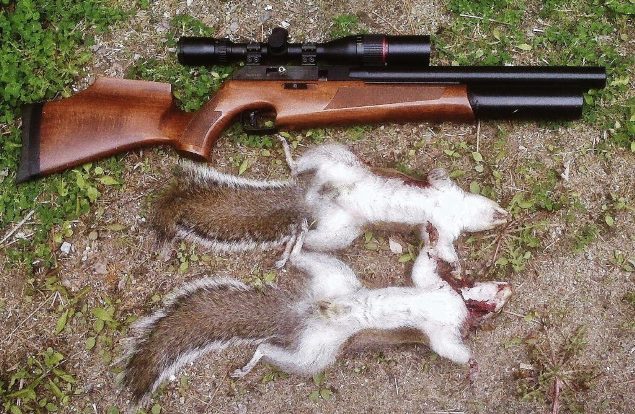
Plain .22 LR solids will work as well or better than most airguns but my favorite load is Remington’s .22 Subsonic Hollow-point. It’s quieter than high-speeds and hits harder than any solids, but won’t tear up a squirrel. Also, a hit anywhere in the upper body will ensure a squirrel dinner.
Also by Steve Markwith, Rimfire Rifles: A Buyer’s and Shooter’s Guide
Rather than blaze away at acrobatic squirrels, I prefer a precise, scoped bolt-action which is also less fussy regarding load options. If noise and carrying range are concerns, try .22 Shorts which use 29-grain bullets. They’ll have more punch than any .22-caliber airgun, and Shorts can even be quieter in rifle-length barrels. Still, to be safe, plan on a maximum carrying distance of a mile.
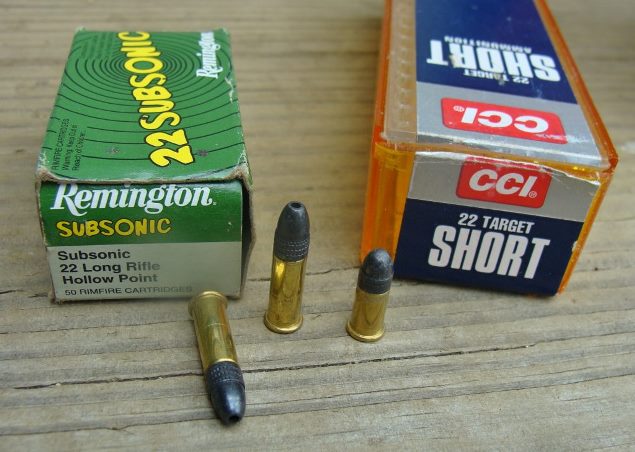
Shotguns for Squirrel Hunting
Any gauge will work, and so will most choke constrictions. Field loads containing #4 – #6 shot will anchor squirrels. Many hunters use repeaters, but my old 12 Ga. H&R break-barrel with its 28-inch full choke barrel was more than up to the task. Thinking back, a 20 Ga. would’ve been less punishing, and less choke might’ve helped at times.
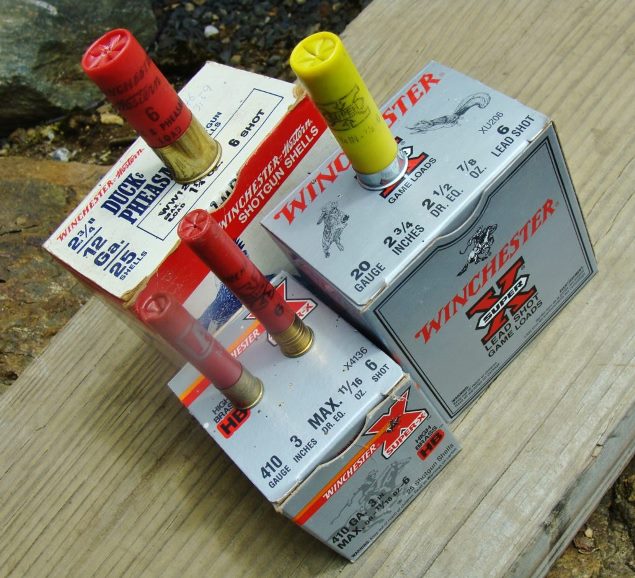
The more mild-mannered .410-bore is really an expert’s gun when used on flushing upland birds, but squirrels offer more deliberate shots. Rumors to the contrary, velocity is similar to the larger gauges. It’s the payload that suffers, particularly in 2 ½” shells that contain a mere ½-ounce of shot. Patterns quickly become skimpy, even using #6s. However, they can be improved in .410s with 3” chambers through use of 11/16-ounce 3” Magnum shells. Many are sold with fixed full-choke barrels which, in this case, is a good thing, simply because the tight constriction will improve pattern density.
Regardless of the gauge, if using #6s, maximum shot-fall distance will be short of a quarter-mile.
Other Guns?
Most air pistols lack sufficient power (with the exception of a few pre-charged types), but .22 handguns are up to the task (assuming the person behind the gun has the skills). Some folks also hunt squirrels with bows, using Flu Flu arrows, fletched to quickly limit their flight. Plenty of squirrels have also been taken by old-time rifle classics like the .25/20 and .32/20, etc. – typically using cast-lead bullets. And, small-caliber muzzleloaders are a hoot when shooting .32 round-balls. But, again carrying range should be factored in when hunting these tree-dwellers!
Gray Squirrel Processing and Cuisine
Assuming you’ve bagged some squirrels, it’s time for skinning and preparation. You can skin a rabbit with your fingers, but that won’t happen with a gray squirrel! (101 Squirrel Hunting Tips)
Fortunately though, there are a few downright clever skinning techniques you can watch on YouTube. The internet is also a great source for recipes. When cooked properly, squirrels are indeed fine dining.
A couple caveats: I’d avoid them in the warmest months, or in areas using control measures that could involve poisons.
Squirrels are a great way to start out young hunters, or any others hoping to give hunting a try. Because the basics have much in common with deer hunting, useful skills can be developed and refined – without breaking the bank on gear. Concerning guns, the above list should cover those of all ages and experience, but always check to see what’s legal in your area. Hunting laws vary regarding methods and seasons. Then, enjoy some autumn social-distancing in the squirrel woods, prepare for a meat shortage and find food independence.
6 comments
I’ve killed and eaten my share over the years. As the article states, it’s a great way to practice the patience and alertness required by larger game hunting.
Here’s my most important tip to new squirrel hunters: When you shoot a squirrel, make a precise mental note of exactly where it fell. And I mean EXACTLY. Many inexperienced hunters will, instead, jump from their stand and run excitedly towards it. Then, amid gray rocks, gray logs, gray saplings…not be able to find their fresh kill. It’s a especially sad when this happens to a young hunter the first time he bags one.
One tip on cuisine: If the squirrel skins easily, it is a young and tender squirrel suitable for pan frying. If it takes you and a buddy to pull the hide off of that critter, you’ve got an old and tough squirrel only suitable for the stew pot. Boil it until the meat falls off, then add potatoes onions, tomato sauce, spices, and flour roux to thicken. Then add anything else that sounds appetizing. That’s what we call Mulligan stew in my part of the country.
But chicken-fried squirrel with mashed potatoes, gravy, and biscuits is far better.
Sound advice.
I’ve hunted my share of ‘tree rats’ in my life. Always used a .22, but used the .22 short round. Squirrel, depending on how you fix it, is great eating. You will develop patience, that can be carried over into other aspects of your life…especially if there are too many witnesses, at the time you want to do something.
We need your recipe!
We need your recipe, too!
Derrick,
The beauty of Mulligan stew is that there is no actual recipe. It’s a hobo stew. Ideally, you’ll need three squirrels for each two gallons of stew. You boil the squirrels in water (salted to taste) ’til the meat is falling off. Then you add potatoes, celery, onions, and carrots. Then you add roux (flour mixed with water) to thicken. Then you set it on a lower temp to simmer.
At this point you continue add…just whatever is available. Canned corn, peas, green beans, hominy, diced tomatoes. Use standard seasonings like pepper, red pepper, garlic, oregano to taste. Let it simmer a couple of hours. Pick out the bones as you eat.
=========
When I fry squirrel, I like to soak the meat in brine for at least four hours. Then you section it. Front quarters, hind quarters, and back cut into two sections. Then shake it in seasoned flour and drop int into about a half inch of hot grease. About seven minutes frying on each side should be right.
Then use the grease to make gravy. Sift some flour in with lots of pepper and a bit more salt. When the flour starts to brown and bubble, add a cup of milk. Bring it to a boil, then reduce to a simmer until it thickens. Keep stirring.
Pour the gravy over potatoes and biscuits. Eat the squirrel just like you would fried chicken.
———-
It’s hard to write a recipe without pics. I hope this helps.
In my part of the country, we probably bag as many Fox squirrels as grays.